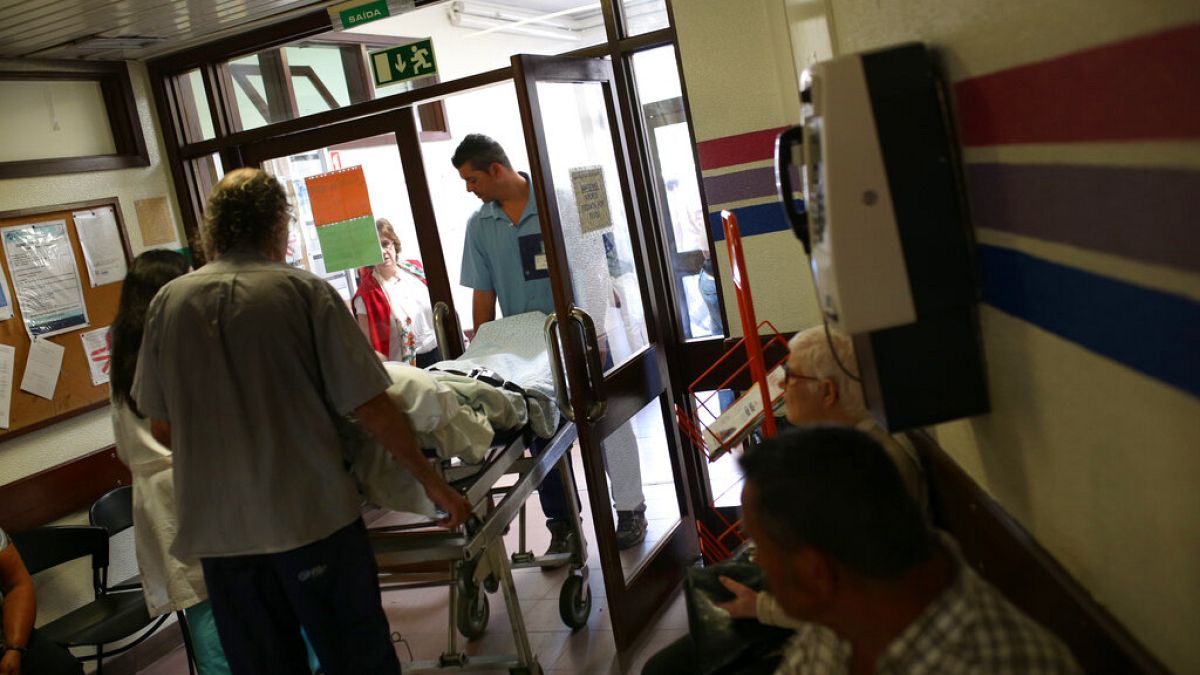New Mexico
Coal stacks dropping signals a transition to a new era – NM Political Report

The ground shook west of Kirtland on Saturday as an explosion echoed along the bluffs. The towers of the San Juan Generating Station that have been a prominent landmark in the area since the 1970s and 1980s crumbled and fell.
The coal-fired power plant has, in many ways, become a potent symbol of the energy transition in New Mexico.
In 2010, the majority owner of the power plant, Public Service Company of New Mexico, received 40 percent of its electricity from two coal-fired power plants in the northwest corner of the state, a percentage that dropped throughout the years.
By 2015, that had reduced to 35 percent.
Then, in 2017, two of the four units at the power plant closed as part of an effort to reduce emissions from the plant.
By 2020, PNM was receiving 27 percent of its electricity from coal.
Next year, the utility anticipates only five percent of its power will come from coal. Meanwhile, renewable energy sources like wind and solar, which were virtually absent from PNM’s resource portfolio in 2010, will likely make up more than half of its generation in 2025.
This transition to renewable energy comes with its own set of challenges.
Kelsey Martinez is the chief of staff and former director of regional markets for PNM. She spoke about some of these challenges during a media event Thursday in Albuquerque.
Martinez outlined how the transition to more intermittent sources of power like solar and wind has led to a greater need for coordination with other utilities in the western United States as well as in parts of Canada and Mexico that are connected to PNM’s system through the grid.
This increase in renewable energy on the grid is leading toward more interconnected operations and regional markets.
Western Energy Imbalance Market
In 2021, PNM joined what is known as the Western Energy Imbalance Market. This changed how PNM works with other utilities if there is a shortage or surplus of electricity on PNM’s systems.
In the past, PNM engaged primarily in bilateral trades in which the company would contact another utility to buy or sell electricity.
Now a computer system evaluates supply and demand for electricity on participating utilities throughout the western United States. An algorithm determines what the most cost efficient and reliable method is for meeting that demand.
While this has become increasingly important for PNM, it still has its limitations. For example, the energy imbalance market does not optimize transmission or provide plans a day in advance.
PNM is working toward more advanced planning and looking for better ways to coordinate with regional utilities.
Regional coordination including regional transmission organizations—-which work together to optimize transmission of electricity—-is not new for electric utilities. Some parts of the country have had their utilities working closely together for a while now.
In New Mexico, Southwestern Public Service, a subsidiary of Xcel Energy, is part of a regional transmission organization.
But, in much of the west, there isn’t a specific entity to coordinate the transmission of electricity throughout the grid.
“In the west,” Martinez said. “We weren’t as quick to adopt regional cooperation policies.”
She said this is in part because the population is not as dense.
“We really built huge baseload power plants with long, high voltage transmission lines to serve our loads,” she said. “And there were not very many of those lines and that’s proving to be very important now.”
Because the eastern United States has a more densely populated area, there tends to be more tightly connected transmission infrastructure.
“So we’re behind and we need to catch up,” Martinez said.
Wind and solar make operations more dynamic and unpredictable, she said.
“That’s creating a lot of new issues that we’ve never seen before,” Martinez said.
PNM is currently working on a 20-year transmission plan that it hopes to release later this year. The plan will outline possible transmission projects that PNM could embark on in the future.
PNM has also been in talks with Pattern Energy about the possibility of connecting to the SunZia line that is being built and will run south of Albuquerque.
The move to renewable resources also changes how PNM must plan.
Before, Martinez said, PNM planned for its peak load, or when people are using the most electricity.
Now PNM must plan for its highest risk hours.
“The times we are at highest risk are when our renewable generation is at its lowest,” Martinez said.
The hardest situation to plan for can be when there is a lot of wind in eastern New Mexico and storm coverage in the Albuquerque area. But that isn’t necessarily because of resource shortages.
Part of the challenge on those days has to do with where the electricity from the wind turbines in eastern New Mexico is going. The power generated by the turbines uses PNM’s high voltage transmission lines as it makes its way across the state to California.
“So our smaller but still high voltage transmission lines serving Albuquerque get constrained in ways we never saw before,” Martinez said.
All of these changes come with a price tag and, while the renewable energy sources tend to be less expensive to operate, the costs of essentially reinventing the grid are eating up those savings.
Demolition underway
The transition, Martinez said, is happening because it is the right thing to do for the climate and environment.
“It’s not because the fuel is cheaper, because the need to expand the grid is going to overrun the cost savings from fuel for decades,” she said.
At the same time, PNM’s analysis that was released in 2017 and predicated the closure of the San Juan Generating Station found that transitioning out of coal would save customers money.
The Energy Transition Act came about as a result of that 2017 announcement and on July 1, 2019—the day that the ETA went into effect—-PNM filed to close the power plant.
In its initial plan, PNM was going to leave the stacks and the generating station standing and the demolition would occur in a few decades.
But the San Juan County Commission passed an ordinance forcing the demolition of the plant.
Even before the stacks fell on Saturday, work was underway to remove the plant from the landscape.
More than 15 million pounds of materials have been recycled so far and the plan is that 90 percent of the material, by weight, will be recycled.
As for the site where the power plant stood, it will still provide a vital service to the grid. The substation that took electricity from the San Juan Generating Station will remain and the San Juan Solar project is connected to the grid at that point.
PNM owns the land and, while the future development of the parcel is uncertain, its proximity to transmission infrastructure is likely to draw interest from energy project developers.
Economic impacts
The closure is a bitter point for some of the San Juan County residents, including some in the City of Farmington who unsuccessfully attempted to keep the plant open through a carbon capture bid.
Farmington Mayor Nate Duckett told legislators this week that the city has made a lot of progress on its efforts to diversify the economy and build recreation opportunities, but that can’t replace what’s been lost.
“We’re trying to replace $100,000 a year jobs with recreation jobs,” he said. “That’s not really feasible.”
He said the hope is that by creating a place where people want to live and play and go to school, Farmington will be able to attract companies that offer higher paying jobs.
The Energy Transition Act has also provided funds for economic development and workforce development in the impacted communities. It also required some of the replacement power to be built within the Central Consolidated School District boundaries in an effort to offset the loss of property tax revenue. This is also providing some short-term employment opportunities.
Tim Gibbs, the CEO of Four Corners Economic Development, told legislators that there has been a decrease in population in San Juan County “but it feels like it’s finding equilibrium.”
As San Juan County works to recover from the loss of the San Juan Generating Station, it is bracing for the closure of the nearby Four Corners Power Plant, which is slated to close in 2031, though once again hopes have arisen that a carbon capture bid could keep it open.
Environment and health benefits
Meanwhile, environmental advocates say the transition from coal will ultimately benefit people living in the Four Corners region.
“We are hopeful that after the demolition of San Juan Generating Station, the Four Corners area and its communities will no longer have to sacrifice our health and safety for fossil fuels,” Rose Rushing, attorney at Western Environmental Law Center, said in a press release. “There is work to be done to ensure that the region can transition to a sustainable, diversified economy, starting with fulfilling the commitments of the Energy Transition Act. We look forward to working with community groups in the next year to make sure our community receives the full benefits the Energy Transition Act promises.”
Some of the people who have been impacted the most by emissions from the power plant are residents of the Navajo Nation.
“Indigenous advocates have long brought attention to the many adverse public health, land, and water quality impacts resulting from the operations at SJGS and Four Corners Power Plant (“FCPP”), pointing out the environmental injustice that Indigenous and local communities were saddled with in living so close to two coal mines and plants”, Robyn Jackson, executive director of Diné C.A.R.E, said in a press release. “We can remember the terrible air quality that both plants produced in our region. It therefore came as no surprise that health disparities existed among our population, compared to the rest of the U.S. general population when it came to childhood asthma, as well as other illnesses like heart disease, cancer, and stroke. Our tribal-led organization recognizes that it is necessary and inevitable that our local economy be rebuilt around development that is renewable, sustainable, and regenerative. The health of our communities, economy and climate will require a transition away from fossil fuels if we are to survive and succeed.”

New Mexico
Slowed growth: New Mexico drops 21 spots in U-Haul’s latest migration report
New Mexico
New Mexico AG files motion to halt $1.9M buyout for WNMU president

SILVER CITY, N.M. — New Mexico Attorney General Raúl Torrez filed a motion to halt a $1.9 million buyout for the departing president of Western New Mexico University.
Joseph Shepard stepped down as president of WNMU after a state audit found he spent $316,000 of university money on lavish international trips, high-end furniture and other items over the course of several years. During the investigation, the state auditor’s office blamed university management and the WNMU Board of Regents for not upholding their responsibilities and enforcing travel rules.
After this, the board approved a $1,909,788 buyout last month for Shepard.
AG Torrez argues the payment isn’t supported by Shepard’s contract and “is unconscionable as a violation of public policy and the public interest.”
“This payment is an egregious misuse of public funds and a betrayal of the Board’s responsibility to act in the best interest of the university and its students,” Torrez said in a statement Monday. “Dr. Shepard voluntarily resigned, and the Board had ample opportunity to negotiate a reasonable or no-cost separation agreement. Instead, they chose to pledge nearly $2 million in taxpayer money without justification or consideration of the public good.”
The New Mexico Department of Justice is requesting the court temporarily block the $1.9 million payment before a hearing can happen. The NMDOJ is requesting the hearing be held before Jan. 15 – the deadline for the payment – or issue an ex-parte order until the hearing can be scheduled. They are also requesting the court prohibit the board from disbursing the payment until a special audit – requested by WNMU, the regents and Shepard – is complete and a report is available.
Shepard’s buyout is just one part of the board-approved separation agreement. The agreement also calls for Shepard to get $200,000 guaranteed for five years as a newly-tenured faculty member once he returns from an eight-month sabbatical. The sabbatical would begin the day he officially resigns. Then, when he returns, he will work remotely.
The agreement drew ire from Gov. Michelle Lujan Grisham, who sent a letter demanding the entire board step down. Before siding with the WNMU Faculty Senate in a unanimous vote of no confidence in the board, faculty senate president Phillip Schoenberg said he heard from the board president that the regents would comply with the governor’s order.
The faculty senate also called on the regents to rescind Shepard’s separation agreement.
New Mexico Higher Education Secretary Stephanie Rodriguez described the buyout as “gross negligence and mismanagement of taxpayer funds.” Her department is also investigating this.
MORE:
New Mexico
‘My staff is spent’: New Mexico emergency management leader reflects on year of disasters

‘That house … is gonna be gone’: A drive through the McBride Fire
McBride Fire in Ruidoso, NM
Chris Bennett, For the Sun-News
This article was originally published by Source New Mexico.
President Joe Biden issued two major disaster declarations in New Mexico in 2024, the first time since 2014 that pronouncement has been made twice in the same year, according to federal data.
First, two wildfires erupted in the Ruidoso area in June. The South Fork and Salt fires and ensuing floods destroyed more than 1,500 homes and caused the deaths of two people. Then, in October, heavy rains caused devastating flooding in Roswell, a disaster that resulted in at least two deaths, as well.
In both instances, and for smaller emergencies before and in-between them, the state Department of Homeland Security and Emergency Management responded.
Disasters of that severity require a multi-faceted response and coordination between numerous officials and local and state agencies. Emergency Management was at the center of all that, running into disaster zones, marshaling resources and fielding questions at angry town halls.
Recently, Deputy Secretary Ali Rye reflected on a year of disasters in an interview with Source New Mexico. She described a tiring year and a small-but-mighty agency that is struggling to keep up with the “before,” “during” and “after” disasters because there have been so many.
“I mean, my staff is spent. I think New Mexicans are spent,” Rye said. “I think everyone is just, they’re tired, and they’re constantly in this response or recovery mode.”
Before 2022, the state had a reprieve of nearly a decade from major disaster declarations, according to Federal Emergency Management Agency data, excluding the COVID-19 pandemic. (Rye doesn’t really count the pandemic she said, “Because everybody got impacted by COVID.”)
The 2022 federally declared disaster was a series of wildfires burning throughout the state simultaneously. On a single spring day in 2022, 20 wildfires were burning at the same time.
That’s the same year that the state experienced the two biggest fires in its history – the Hermits Peak-Calf Canyon Fire in northern New Mexico and the Black Fire in southern New Mexico. Both burned more than 300,000 acres.
The trial by fires, while devastating for communities and exhausting for staff, has at least been educational, Rye said.
“I will tell you, though, we have learned a lot over the last two years,” she said. “And I think it showed this year with us being very proactive in areas that we knew were going to get hit, or us planning ahead for fire season, for monsoon season in a more proactive way.”
That meant meeting with residents and local officials in disaster-prone areas, purchasing needed equipment and staging it there in advance, Rye said.
The ongoing fallout from the Hermits Peak-Calf Canyon Fire shows the long tail – and cumulative nature – of disasters. More than two years later, even as disasters unfolded in southern New Mexico, staff was still driving all over the state, offering state case managers to help northern fire victims navigate a tangle of bureaucracy and support to local officials still trying to rebuild roads or mitigate against future floods.
“The same staff that help in Roswell and in Ruidoso are also the same staff that help in Hermits Peak-Calf Canyon,” Rye said. “And so my staff, I mean, they travel all over the state to be able to provide the assistance and the resources to these individuals who are still in these communities that are still recovering.”
Rye’s core staff is two people, she said, though the office does employ others with the help of federal grants. “So, yeah, it’s a lot,” she said.
But it’s rewarding and vital work, she said, helping people on the worst days of their lives. The office is hiring, and Rye is hoping to convince lawmakers to increase its operating budget from about $3.2 million to about $5.6 million at the upcoming 60-day session. The extra funding would help attract and retain staff, many of whom are lured away by federal disaster response agencies or elsewhere.
As it stands, the skeleton crew can’t take as much time as needed to help a community recover or prepare before another flood, snowstorm or wildfire.
“We’re going so much that we cannot put in those mitigation efforts the way we really, truly would like to,” she said. “We’re kind of just putting Band-aids on situations to keep the state afloat.”
Patrick Lohmann has been a reporter since 2007, when he wrote stories for $15 apiece at a now-defunct tabloid in Gallup, his hometown. Since then, he’s worked at UNM’s Daily Lobo, the Albuquerque Journal and the Syracuse Post-Standard.
-

 Health1 week ago
Health1 week agoNew Year life lessons from country star: 'Never forget where you came from'
-
/cdn.vox-cdn.com/uploads/chorus_asset/file/24982514/Quest_3_dock.jpg)
/cdn.vox-cdn.com/uploads/chorus_asset/file/24982514/Quest_3_dock.jpg) Technology1 week ago
Technology1 week agoMeta’s ‘software update issue’ has been breaking Quest headsets for weeks
-

 Business6 days ago
Business6 days agoThese are the top 7 issues facing the struggling restaurant industry in 2025
-

 Culture6 days ago
Culture6 days agoThe 25 worst losses in college football history, including Baylor’s 2024 entry at Colorado
-

 Sports6 days ago
Sports6 days agoThe top out-of-contract players available as free transfers: Kimmich, De Bruyne, Van Dijk…
-

 Politics4 days ago
Politics4 days agoNew Orleans attacker had 'remote detonator' for explosives in French Quarter, Biden says
-

 Politics4 days ago
Politics4 days agoCarter's judicial picks reshaped the federal bench across the country
-

 Politics2 days ago
Politics2 days agoWho Are the Recipients of the Presidential Medal of Freedom?















